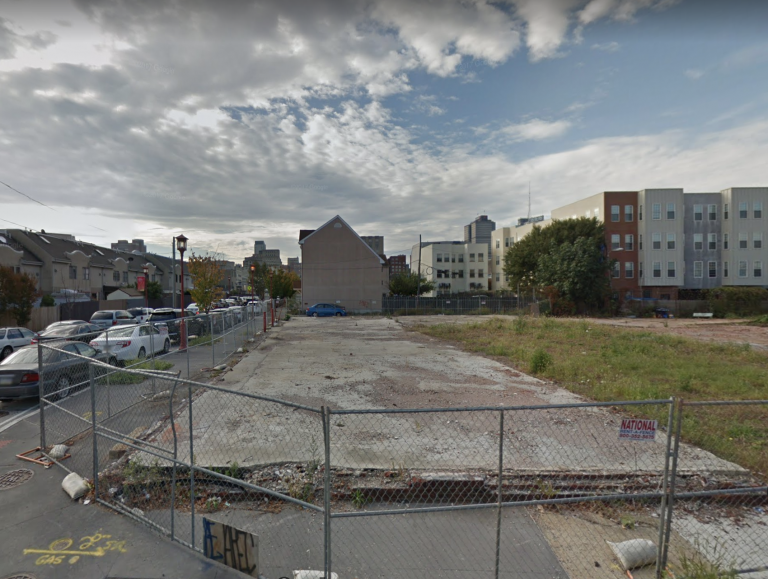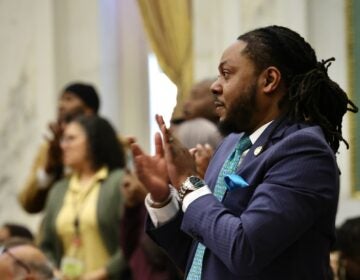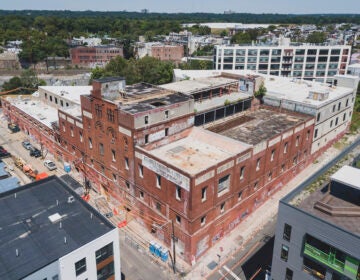Trump’s development tax break presents ‘unusual’ opportunity for Philly, Drexel fellow says
The Treasury Department this month issued proposed guidelines for the program, which includes 82 zones in Philadelphia, 300 in Pennsylvania.

900 Callowhill St., Philadelphia (Google Streetview)
This article originally appeared on PlanPhilly.
—
A 35,000-square-foot lot at 900 Callowhill Street has been sitting vacant for over a year, hosting little more than a patch of weeds as the neighbors wait for hard hats to show up and break ground on a promised mixed-use development.
The site is in a prime location, just north of Chinatown and a half-mile from Center City. The new Rail Park is nearby, development is booming along Callowhill, and the developer is already approved to build 146 apartments and 12 retail spaces. John Chin, executive director of the Philadelphia Chinatown Development Corporation, believes that just one missing element has kept builders from getting started on the $20 million-plus project: money.
“That’s my best guess, because it did get zoning,” Chin said. “Any time someone gets zoning, your next steps are complete construction plans, L&I building permits, and financing.”
With housing in demand, Chin is intrigued by the prospect of an influx of development funding from the Opportunity Zone program, a new federal tax credit for business investment in designated low-income districts, including Chinatown and surrounding neighborhoods. The Treasury Department this month issued proposed guidelines for the program, which includes 82 zones in Philadelphia, 300 in Pennsylvania, and over 8,700 census tracts across the country.
Although it remains to be seen exactly how the investments will work, Chin said he’s excited to see if the program will finally spark developments like 900 Callowhill, along with affordable housing projects and small-business investments that would benefit Chinatown’s immigrant community.
“It’s a federal policy that can bring tremendous benefits to neighborhoods such as Chinatown, which has a significant poverty rate. If used appropriately, and if tools and guidelines are created to maximize its benefit for all people, it’s a fantastic tool, not unlike New Market Tax Credits or Low-Income Housing Tax Credits,” he said.
Unlike those and other existing tax incentives, however, the Opportunity Zone program does not narrowly specify the type of project that qualifies, attempt to measure or control its social effects or funnel money through state or local agencies that can steer funding into needed investments. Congress simply approved the incentive as part of last year’s tax law and left it to the financial and real-estate markets to figure out how to use it.
“There’s going to be a combination of the good, the bad, and the ugly,” said Bruce Katz, director of the Nowak Metro Finance Lab at Drexel University. “This is a market tool. It’s not really a policy tool. It’s not like the Low-income Housing Credit or the New Markets credit or the Historic Preservation Credit, which are very targeted and very circumscribed. This is a market tool, and there’s the potential for this market tool to be very impactful in a lot of places in the U.S. that are either neighborhoods that are struggling within the cities or entire cities that are struggling.”
“Bottom line, there’s really no predictability for the outcome of this. This is what the country makes it to be, for the most part. That’s what makes this a highly unusual exercise,” he said.
Local governments and civic organizations need to “act decisively” to encourage the right projects, if the Opportunity Zones are to lead to inclusive and sustainable growth rather than a series of disconnected individual business transactions, according to a report co-written by Katz and financial analyst Evan Weiss. Weiss previously worked for U.S. Senator Cory Booker, who co-sponsored the Opportunity Zone legislation, and has helped cities and states design place-based opportunity funds.
The report is the first to come out of the new urban-focused Drexel lab, part of the Lindy Institute of Urban Innovation and named after local investor and civic leader Jeremy Nowak, who passed away in July.
Nowak and Katz co-wrote the 2018 book, “The New Localism: How Cities Can Thrive in the Age of Populism,” in part as a response to the election of President Donald Trump. The book argued that cities, as long as they are willing to work with the private sector, are better positioned than state and federal bureaucracies to experiment with new solutions for seemingly intractable problems like poverty. Despite Nowak’s opposition to Trump, he was excited by the Opportunity Zone policy, colleagues said.
The new report argues that cities should be proactive and assemble prospectuses to promote feasible projects, involve anchor institutions like universities and hospitals, include city-owned properties, and create business districts. Other priorities should include helping local businesses, particularly women- and minority-owned firms, access capital and technical assistance; training workers; and supporting affordable housing production.
Philadelphia could face a challenge in getting investors to put their money in needier areas rather than districts that are already booming or targeted for big projects. The Opportunity Zones cover Point Breeze, Northern Liberties and parts of Kensington, and areas near Drexel and the University of Pennsylvania, among others. A new Treasury rule would additionally allow 30 percent of a qualifying business’s property to be outside of any zone.
Critics say a surge of investment dollars looking for projects could also lead to construction of housing that is out of reach for current residents of low-income Opportunity Zones, accelerating the gentrification of Center City and other areas.
If that happens, “low-income folks are just going to be pushed further out,” Chin said. “If the city doesn’t come up with a citywide policy to manage development, you might as well just carve out a section of the city and have all low-income families live in that area. In many ways the market is driving that already. Center City is getting much larger and low-income families are just being pushed further out.”
That’s why the city must craft much stronger policies to encourage the creation of affordable housing, along the lines of an inclusionary zoning bonus and funding measures City Council approved earlier this month, Chin said. He said he also wants to see Opportunity Zone investments in small businesses like Chinatown restaurants, which provide a crucial economic pathway for immigrants who face language barriers and other employment challenges.
Katz said it is up to local officials, economic development coordinators, financiers, lawyers and other experts to figure out how to combine Opportunity Zone investments with other private and public funding and create a model that works for projects like those Chin is advocating.
“We should be able to do this, because, particularly in a city like Philly, you have real capacity among practitioners. People actually do know how to get this done,” he said. “Philly may actually be one of those places that invents the new model, and then other places in the country begin to replicate it.”
To take advantage of the program, individuals and companies can take profits from unrelated investments, put them in a privately created Opportunity Zone fund, and avoid paying taxes on those previous gains through 2026. The longer they wait before cashing out, the greater the tax savings, with a top benefit of 15 percent. They also won’t have to pay any capital gains taxes on zone investments held for at least 10 years.
Treasury Secretary Steven Mnuchin said the program could spur $100 billion in private investment.
WHYY is your source for fact-based, in-depth journalism and information. As a nonprofit organization, we rely on financial support from readers like you. Please give today.







